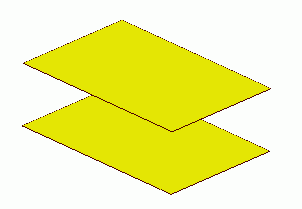
CAE Software【Femtet】Murata Software Co., Ltd.

Example1 Parallel-Plate Air-Gap Capacitor

General
-
The capacitor analyzed in this exercise consists of two parallel conductive plates which have the potential difference.
-
The capacitance, the electric field, and the equipotential map are solved.
-
Unless specified in the list below, the default conditions will be applied.
Analysis Space
|
Item |
Settings |
|
Analysis Space |
3D |
|
Model unit |
mm |
Analysis Conditions
Select “Static analysis” as the potential is static.
|
Item |
Settings |
|
Solvers |
Electric Field Analysis [Coulomb] |
|
Analysis Type |
Static analysis |
|
Material Type |
Dielectric material |
|
Options |
N/A |
The electric field exists outside the analysis region. Therefore the open boundary condition below is applied initially.
|
Tab |
Setting Item |
Settings |
|
Open Boundary Tab |
Type |
Absorbing boundary |
|
Order of Absorbing Boundary |
1st degree |
Model
Create 2 sheet bodies for electrodes. Then, specify the voltage on each as boundary condition.

Body Attributes and Materials
Two sheet bodies are not the physical entity. They are used just to imprint the voltage-specified boundary condition.
They are called “imprinting body”.
You don’t need to set the body attribute or the material property on them.
|
Body Number/Type |
Body Attribute Name |
Material Name |
|
1/Sheet |
Imprinting body |
|
|
2/Sheet |
Imprinting body |
|
* Available from the Material DB
Boundary Conditions
|
Boundary Condition Name/Topology |
Tab |
Boundary Condition Type |
Settings |
|
Electrode1/Face |
Electric |
Electric wall |
Voltage specified, -1[V] |
|
Electrode2/Face |
Electric |
Electric wall |
Voltage specified, +1[V] |
|
Outer Boundary Condition * |
Electric |
Open boundary |
To set Outer Boundary Condition, go to the [Model] tab

and click [Outer Boundary Condition] ![]() .
.
Results
To see the calculation results, go to the [Results] tab

and click [Table] ![]() .
.

The vectors of the electric field are shown below.

The electric field is generated between two plates.
The gradation contour of the voltage on the XZ section is shown below.

The distributed voltage around the electrodes is visually shown.

